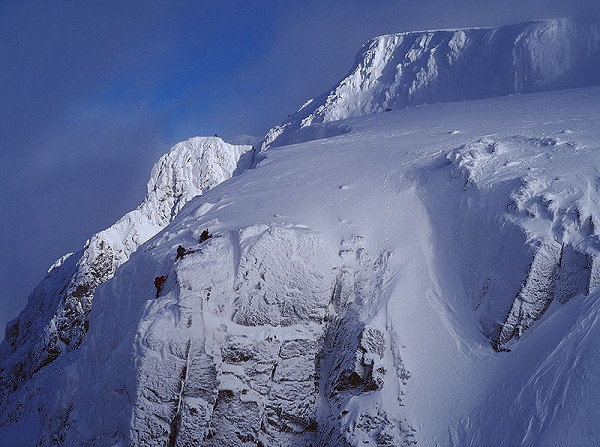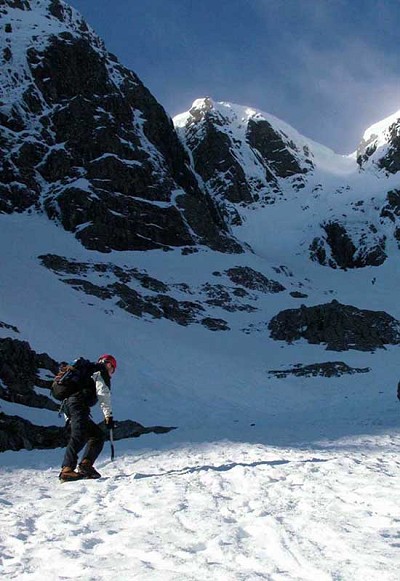
Note: UKClimbing recognises that solo climbing is a dangerous activity. Both on UKClimbing.com and in Rockfax guidebooks, we have a general policy of not overtly crediting solo ascents except where appropriate (eg. deep water soloing). This article has been published because it is an interesting account of the approach of the soloist but in general we do not advocate this approach to climbing and mountaineering.
"I live life passionately; there is great pleasure in this and it takes care of everything."
Catherine Destivelle
The vehicle rocks from the implacable winds. I curl up in the back of the car, trying to stay warm. I am parked at the side of a gravel road in the Scottish highlands. It is three o'clock in the morning in the dead of winter and I have to get up soon. My mind races. Success or failure today will centre on the vertical, smooth corner halfway up Britain's highest wall.
I have rehearsed the scene many times in my head. The very same storms which now rage and are a curse to most, may prove to be my saviour. If they have coated the crucial slab with even a centimetre of ice, I will climb it. If the slab is blank, it will mean an entirely different scenario and, for now, unthinkable.
My life is filled with innumerable adventures, past, present and future. All are interlinked and all have brought me here to this physical and emotional juncture. Some adventures are light-hearted and fun, others serious and risky. They have accompanied me from childhood to adulthood, from distant dreams to stark reality, shaping me for better and for worse. I have stood in awe and knelt in tears. They can be, at once, invigorating and exasperating. Above all, they are life-affirming, a step into the unknown and a glimpse of the extraordinary.
Elemental forces seem to be conspiring as I try, quietly, to evade their clutch on my way up the shallow valley to the CIC Hut. The darkness only adds to this harbinger of doom. A mob of deer scatter from the path, the only company I encounter on the approach. The hut's wind turbine is threatening to relocate itself and, at this rate, must be generating enough electricity to power Fort William. I find my usual spot around the side of the building where I pause for a drink.
“I keep my head down and march on, but this is not a march towards oblivion. There is no blind optimism nor dramatics but a steely, unshakeable will to either succeed or fail safely.”
A hooded figure appears and politely invites me into the hut for shelter. I thank him but decline as my day is just beginning. I smile at the irony of it. The SMC's official position is that, "Visitors staying at the huts have no authority to allow casual persons to use the huts, whether they are members of other mountaineering clubs or not, except in cases of emergency."
The irrepressible Dave MacLeod, along with a visiting US climber, walks past, bound for the first winter ascent of Steam Train (VI,7). I shoulder my 'sac and leave for my own objective, recalling its birth, in February 1983. From the SMC guidebook: "In another act ahead of its time, it was Cuthbertson who first plucked up the courage to pick a way delicately across frighteningly thin and unprotected iced slabs and ramps in the middle of Ben Nevis's Indicator Wall to produce the exceptionally serious Stormy Petrel (VII,6)."
Scotland's answer to Canada's Sea of Vapours, Stormy Petrel is the epitome of thin face climbing, encapsulating all the delights and horrors of this particular form. The route's features are incredibly aesthetic and exposed, linked by a sustained and compelling line.
In the mid-1990s, Jim Blyth did a review of the latest SMC guide to the mountain, and ranked Stormy Petrel as number one in a list of "Top Ten Routes with Attitude (or the thinnest, least protected desperates)." Others in the list (and still as relevant) included Urban Spaceman (VII,6) and Point Blank (VII,6). The handful of ascents that these three routes combined have had is testimony to both their fleeting and, quite frankly, scary nature.
Krzysztof Wielicki
The purgatorial slog up Observatory Gully is normally alleviated by striking rock architecture and the hatching of prospective plans but today it is all being swallowed by blizzards. I keep my head down and march on, but this is not a march towards oblivion. There is no blind optimism nor dramatics but a steely, unshakeable will to either succeed or fail safely.
I stomp out a large stance in the 55-degree slope at the base of Indicator Wall. I want a clear look at the middle section of the route which is proving impossible in the tempest. I know the final chimney, which acts as a funnel for the exit slopes, will have forged a healthy vertical icefall, but it is the steep corner beneath the hanging slab where my hesitancy lies. I wait for a window in the storm.
No sign of life exists anywhere in this sector of the mountain. Keeping my 'sac on, I turn away from the wind and burrow further into my hood. I think of Krzysztof Wielicki, one of the world's most outstanding mountaineers, who is trying to "infect" a new breed of Polish climbers with "the joy of positive suffering - because if something is easy, you will not enjoy it, really."
After a while, I watch two souls toil steadily up towards me. They are lost French guides, based in the hut for a week, and are searching for Hadrian's Wall Direct (V,5). We talk, for myself I am grateful for the distraction. I point them back down the gully to the west face of Observatory Ridge. They seem happy to be on the move again.
Finally, after two hours on my stance, visibility improves enough for me to snatch a brief glance at the crux. It is plastered white which is all I need to know. I go through my ritual, a practical checklist that also settles my mind. I adjust my helmet strap, inspect my crampons and tighten my gloves. Stepping out from the platform, I embrace the initial ramp.
There is little evidence of the blizzard dissipating but it doesn't matter. My senses are too focused on my own preservation. One hundred feet directly upwards, my world is darkened by black roofs looming overhead as I look across the face. The much-exalted Rhyme of the Ancient Mariner (VII,7) is off to my left, while my interest lies diagonally right. Ribs of rock, like the vertebrae of a fossilised skeleton, interrupt the traverse but the ice is excellent. Typically, thin face routes are not overly technical, but they do require a calm disposition.
“The only avenue open to me now, ropeless as I am, is to reverse my moves. I have approximately 200 feet to cover.”
I lean out from a large slab then tip-toe higher into the corner. Poised below the decisive 90-degree left wall, I tap against the surface. The blunt sound of metal hitting rock reverberates back to me. I try another section, scraping the pick in an arc. The tool grates, as do my nerves. I gain another metre by inching my front points up the good ice immediately below the wall, my nose virtually pinned against the slab so as to stay in balance.
Raising each tool in turn, I sweep the white veil, hoping to detect a sliver of frozen water. It doesn't work. I excavate a line of snow deep in the corner where there is a crack. Sadly, it offers no assistance and, moreover, leads into an impassable roof. Arching my back, I can see the top of the wall but it is out of reach. The hanging slab, gateway to the upper half of the route, is just over the lip, tantalisingly close but frustratingly unobtainable.
The wall has presented a misleading illusion with its ephemeral blanket of cotton wool rime, disintegrating at a stroke. Jim Blyth's prophetic words echo in my mind. "It's essential to be able to assess whether or not a route is in. Halfway up the slabs on Stormy Petrel isn't the place to decide it's not in nick!" In their own attempt five days later, Blair Fyffe and Iain Small would be impelled off-route at the very same spot.
The only avenue open to me now, ropeless as I am, is to reverse my moves. I have approximately 200 feet to cover. Downclimbing efficiently is an invaluable skill requiring constant vigilance. Countless hours of bouldering circuits, refining coordination and psychological adaptability, has given me confidence in this particular discipline. As such, there is no panic as I begin to retrace my steps. Besides, panic, and the propagation of it, is futile and self-defeating.
Staring between my legs, an updraft of spindrift rips at my eyes and flesh. There has been an intensity shift in the weather, and the pitiless winds want to wrench me from the face. I consciously tell myself to ensure every placement of tool and crampon is as solid as can be. A high level of awareness, acquired over a kaleidoscope of experiences, underlines my behaviour.
Each time the howl of the blizzard builds to a crescendo, I press fully against the ice, patiently awaiting a lull. Backtracking a rising traverse in such poor conditions is not easy, and I am keen to avoid the broad undercut roof which lies somewhere beneath my heels. With measured progress, and admittedly a little relief, I touch back down to Earth.
While fundamentally a failure, these fragments of dreams will undoubtedly contribute towards future endeavours. Unable to quite leave it at that however, I headed for the classic Grade V, Observatory Buttress, to vent some unexpended energy.
- State of Nakedness 9 Dec, 2009
- The Tyranny of Success 10 Dec, 2008
















Comments